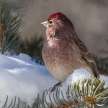
The ornate tinamou (Nothoprocta ornata) is a type of tinamou typically found in high altitude grassland and dry shrubland in Central South America subtropical and tropical west regions. Ornate Tinamou is a typical member of Large Andean family, Nothoprocta. From the south of central Peru through Bolivia to Argentina and Chile, these species occupy steppes of high elevation, especially hills dominated by bunch grass at 3500-4800 m. The Ornate Tinamou, if viewed from afar before it flushes, appears to be a fairly smooth blend of earth tones. However, when seen at close range, Ornate Tinamou appears to live up to her name: the female is very striking, being heavily patterned over the back and wings with white edgings and bandages. Tinamous are woodland birds with relatively short tails and long wings; they mimic shallow quails. Ornate Tinamou is a large tinamou with long crown feathers, which are often lifted, forming a bushy crest. The top pieces are mainly ochraceous grey, intricately patterned with vermiculations, bars and brownish white, brown, black, and light buffy yellow to tawny buffs. The subparts are typically grey and less marked, light on the abdomen and buffered. The southern populations appear to be bigger, lighter and more browner than the animals in northern and central Peru. Ornate Tinamou lives in open high elevation habitats from central Peru, in Ancash's western Andes, south to southern Peru, west Bolivia, northern Chile, and northwest Argentina. The diet of Ornate Tinamou includes "clover and other small leaves, beans, blooms, nuts, berries, plants of the heart, fruit and vegetables" You will repeat this call for up to three hours, at 3-20 s intervals. More widely heard is a call of unknown origin, identified as eee-arr. Most of the information on the general behaviour of Ornate Tinamou derives from. These tinamous people spend all of their time on the edge, even as they climb high positions like sunbathing, preening, or naming boulders. The head is usually left down while the tinamous feeds but the bird raises its head to look around for a few pecks. When irritated these tinamous also cover up behind a clump of grass for accurate observation. A pair of Ornate Tinamous can fly very slowly when foraging, taking up to two and a half hours to feed on an area of about 0.2 ha; solitary birds search more briskly and occupy more ground. A fast beat of wings initiates takeoff, but then the wings are kept silent and the tinamou executes a glide, landing out of sight, if possible, after covering about 50-200 metres. Nearly all flights are downhill, and at arrival, the bird always races even faster. In fact, the usual evasive action is sprinting away for up to 20 m and then squatting under a clump of grass or tola. Ornate Tinamou most commonly feeds on lush green seps, usually low on the hillsides or along the valley floors. Some people migrate downhill to 200 m to feed on seeps, and then back uphils. If a bird of either sex is agitated, it can draw the feathers into what appears to be a black crest. On the female of Ornate Tinamous the crest is most commonly seen. Courtship mainly consists of offering follow-up meals. The male forages in front of the female and displays either head or tail towards the female, raising the rump and spreading the feathers of the tiny rumps at the same time, frequently twittering and squeaking. The rising rump shows crissum feathers spotted in rust and a slight dark patch on each side of the vent. The female then normally dashes away from one to three m, generally from a position in front behind the male. The demonstration may be repeated if the female sits at the end of the dash; and if the female squats at the end of the dash, copulation immediately happens.
About the Creator
MB
I am a bird aficionado and really enjoy spotting them them on hikes. I greatly appreciate the variety of birds cross North America and the world. They are amazing and intelligent creatures, each so unique and with a wonderful life.






Comments
There are no comments for this story
Be the first to respond and start the conversation.